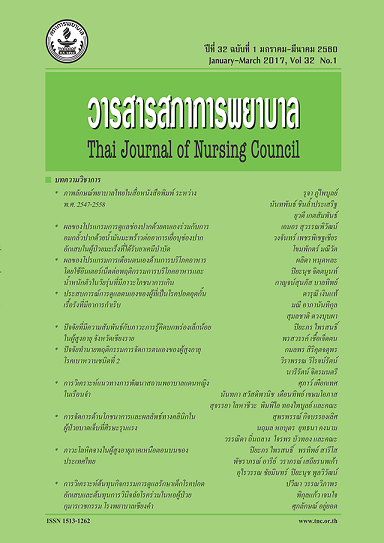การวิเคราะห์แนวทางการพัฒนาสถานพยาบาลแดนหญิงในเรือนจำ;Analysis of Approaches to Improving the Healthcare Facility for Women's Inmates
Keywords:
แนวทางการพัฒนา, สถานพยาบาลแดนหญิง, ผู้ต้องขังหญิง, เรือนจำ, developmental approaches, healthcare facility, female inmates, prisonsAbstract
วัตถุประสงค์การวิจัย : เพื่อประเมินสถานพยาบาลแดนหญิง วิเคราะห์ปัญหาหรืออุปสรรคในการพัฒนาคุณภาพการจัดบริการด้านสุขภาพ และวิเคราะห์แนวทางการพัฒนาสถานพยาบาลแดนหญิง
การออกแบบวิจัย : การวิจัยเชิงบรรยาย
การดำเนินการวิจัย : เก็บข้อมูลเชิงปริมาณโดยใช้แบบประเมินสถานพยาบาลแดนหญิง และเก็บข้อมูลเชิงคุณภาพโดยการสัมภาษณ์ การสังเกต และการตรวจสอบเอกสาร ตั้งแต่เดือนสิงหาคมพ.ศ. 2558 ถึงเดือนพฤษภาคม พ.ศ. 2559 ผู้ให้ข้อมูล ประกอบด้วย 1) ผู้บริหาร พยาบาล และ
เจ้าหน้าที่ รวมจำนวน 44 คน 2) ผู้ต้องขังหญิงจำนวน 121 คน และ 3) กลุ่มผู้มีส่วนได้ส่วนเสียในการประชาพิจารณ์แนวทางการพัฒนาสถานพยาบาลแดนหญิงจำนวน 43 คน วิเคราะห์ข้อมูลเชิงปริมาณด้วยสถิติบรรยายและข้อมูลเชิงคุณภาพด้วยการวิเคราะห์เนื้อหา
ผลการวิจัย : สถานพยาบาลแดนหญิง 7 ใน 14 แห่ง ผ่านเกณฑ์การประเมินตามมาตรฐานสถานพยาบาลแดนหญิง ผลการวิเคราะห์แนวทางการพัฒนาสถานพยาบาลพบประเด็นดังนี้ 1) มาตรฐานการบริหารจัดการสถานพยาบาลแดนหญิงในส่วนของบริบท คือ 1.1) นโยบายและงบประมาณการดูแลสุขภาพ และส่วนปัจจัยนำเข้า คือ 1.2) อัตรากำลังบุคลากร 1.3) การพัฒนาศักยภาพบุคลากร 1.4) ระบบการทำงานร่วมกัน 1.5) ความพร้อมของสถานพยาบาลและ 1.6) การสร้างเครือข่ายภายนอก 2) มาตรฐานการจัดบริการด้านสุขภาพในแดนหญิง คือ 2.1) การสำรวจและวิเคราะห์ปัญหาด้านสุขภาพ 2.2) การจัดบริการด้านสุขภาพครบทุกมิติ 2.3) การจัดทำและดำเนินการตามแนวปฏิบัติ 2.4) การพัฒนาระบบการจัดเก็บและวิเคราะห์ข้อมูลด้านสุขภาพ 3) มาตรฐานผลลัพธ์จากการจัดบริการด้านสุขภาพในแดนหญิง คือ 3.1) ความพึงพอใจในบริการสุขภาพ 3.2) ความรู้ความเข้าใจในภาวะสุขภาพ 3.3)อุบัติการณ์โรคติดต่อรายใหม่ลดลง และ 3.4) ผู้ต้องขังหญิงกลุ่มเสี่ยงได้รับการคัดกรองโรค
ข้อเสนอแนะ : แนวทางการพัฒนาสถานพยาบาลแดนหญิงที่ได้จากการศึกษาครั้งนี้สามารถนำไปใช้พัฒนาคุณภาพการจัดบริการด้านสุขภาพได้อย่างเป็นรูปธรรม โดยบุคลากรและหน่วยงานระดับต่างๆ ของกรมราชทัณฑ์มีส่วนร่วมรับผิดชอบดำเนินการภายใต้ความร่วมมือจากภาคีเครือข่าย
Objectives: (1) To assess the condition of healthcare facility for women's
inmates ; (2) to analyse problems and obstacles hindering
the stations’ healthcare quality improvement;
and (3) to analyse developmental approaches to improving the healthcare facility.
Design: Descriptive research.
Procedure: This study was based on both quantitative and
qualitative data collected at 14 prisons. The quantitative data were
collected using a form designed to assess the condition
of healthcare facility women’s inmates. The qualitative data
were obtained by means of interviews, observation and
a documentary review, all of which took place between
August 2015 and May 2016. The informants consisted of
(1) 44 prison staff members, including administrators, nurses and offcials;
(2) 121 female inmates; and (3) 43 stakeholders engaged
in the referendum on proper approaches to improving healthcare
facility for women's inmates. Descriptive statistics
and content analysis were used to analyse the quantitative
and qualitative data, respectively.
Results: The healthcare facility in 7 out of the 14 women’s
inmates studied satisfied the Women’s Inmates healthcare
facility Standard Assessment. An analysis identifed the following
issues as necessitating improvement on the medical stations:
(1) contextual aspects of women’s inmates management standards;
(2) health service standards for women’s inmates; and
(3)health service outcome standards for women’s inmates.
The contextual aspects of women’s prisons management standards
involved 6 elements, namely, (i) healthcare policies and budgets;
(ii) personnel; (iii) personnel’s potential development;
(iv) teamwork systems; (v) readiness of each healthcare facility;
and (vi) external networking.The health service standards for
women’s inmates involved 4 elements, namely, (i) survey and
analysis of health problems; (ii) provision of all-faceted
healthcare services; (iii) implementation and operation
in accord with the developmental approaches; and
(iv) development of a health records
storage and analysis system. The health service outcome standards
for women’s inmates involved 4 elements, namely,
(i) recipients’ satisfaction with healthcare services; (2) recipients’ knowledge
and understanding of health conditions; (iii) decrease in
new cases of contagious diseases;and (iv) screening process
for risk-group female inmates.
Recommendations: It can be suggested that these developmental
approaches be concretely applied to healthcare service provision
by the staff in the various sections of the Department
of Corrections, in cooperation with other member organisations
of the collaborative network.








